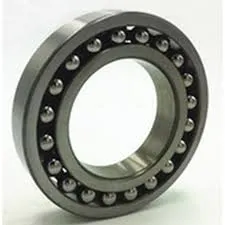
Oct . 30, 2024 13:37 Back to list
single row cylindrical roller bearing
Understanding Single Row Cylindrical Roller Bearings
Single row cylindrical roller bearings are crucial components in a wide range of mechanical applications. Known for their high load-carrying capacity and ability to accommodate radial loads, these bearings play a significant role in various industries, including automotive, aerospace, and industrial machinery.
A single row cylindrical roller bearing consists of an outer ring, an inner ring, and a complement of cylindrical rollers that are arranged parallel to the axis of rotation. The design allows the rollers to distribute loads evenly, which minimizes stress concentration and prolongs the bearing's lifespan. This is particularly important in applications where equipment experiences heavy loads or rapid speed changes, as the roller design reduces friction and wear.
One of the primary advantages of single row cylindrical roller bearings is their high radial load capacity. The line contact between the rollers and raceways enhances load distribution, making these bearings suitable for heavy-duty applications. Additionally, due to their cylindrical shape, these rollers can handle both axial and radial loads, which adds versatility to their use.
single row cylindrical roller bearing

Installation and maintenance of these bearings is relatively straightforward. Typically, they are pressed into place using appropriate tools, ensuring a snug fit between the bearing and the housing. Regular monitoring for wear and tear is essential to ensure optimum performance; however, their robust design often translates to lower maintenance requirements compared to other bearing types.
In terms of materials, single row cylindrical roller bearings are made from high-quality steel or even ceramic composites in specialized applications. This choice of materials enhances their durability and resistance to harsh operating conditions, including temperature fluctuations and exposure to corrosive environments.
The operational efficiency of these bearings is also facilitated by various lubrication methods, such as grease or oil, which reduces friction between the rollers and raceways. Proper lubrication is vital for reducing heat buildup and ensuring the longevity of the bearing.
In conclusion, single row cylindrical roller bearings are invaluable in powering machinery and equipment across diverse sectors. Their ability to handle substantial radial loads with minimal friction makes them a preferred choice for engineers and designers looking for reliability and efficiency in design. Understanding their characteristics and application methods can greatly enhance performance and durability in engineered systems.
Latest news
-
Premium Deep Groove Ball Bearings | High Speed & Reliability
NewsAug.29,2025
-
Durable Scaffolding Clamps - Secure & Reliable Tube Connectors
NewsAug.28,2025
-
Common Failures in Thrust Ball Bearings and Solutions
NewsAug.22,2025
-
How Tapered Roller Bearings Can Take Shock Loads
NewsAug.22,2025
-
Angular Bearings in High-Precision Spindles
NewsAug.22,2025
-
The Impact of Misalignment on Cylindrical Roller Bearing Performance
NewsAug.22,2025
